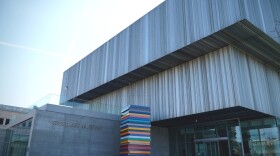89.3 WFPL News Louisville · King Louis Statue’s Fate Remains TBD, While City Looks Forward On Public Art
The statue of King Louis XVI that once towered over passers by outside Metro Hall is now in storage, awaiting conservators to look it over.
“There's no other plans in place right now except getting a thorough understanding of its condition,” said Louisville public art administrator Sarah Lindgren.
It’s been several weeks since the city quietly removed the statue of the former French ruler.
According to the city, crews took it down because there were concerns that any more damage to it could make it a public safety liability. And while there are no immediate plans regarding the final fate of King Louis XVI’s nine-ton marble likeness, Lindgren and the Commission on Public Art (COPA) are looking forward, discussing plans for the Metro’s larger public art profile.
‘What We Don’t Have’ Vs ‘What We Do Have’
Lindgren said, other than opinions shared on social media, she hasn’t heard overwhelming support in favor of either returning the King Louis XVI statue to public or keeping it in storage.
For her though, especially when considering thepublic process that was done a couple of years ago around debates over the John B. Castleman statue, “it becomes obvious that the problem is as much what we don't have as what we do have.”
“Of course, there are things that maybe have controversies around them or questions around them, but when we look at who is represented and who is not represented in that collection, there's a lot of gaps and and that is as much a problem as any one controversy in an existing artwork,” Lindgren said.
What’s missing from the city’s “landscape of public art,” has been a focus for Lindgren and COPA lately.
At a Sept. 14 COPA meeting, the members of the commission discussed a two-year proposed “public art investment plan” that they hope will address some of the gaps in the city’s public art program.
The proposed plan would be a public-private partnership, tentatively, with Community Foundation of Louisville to work with St. Paul, Minn.-based public art consulting firm Forecast. As part of the plan, Forecast would conduct an audit, looking at the city’s public art calls for submissions the past few years to help draft a standard public art RFQ for the city, Lindgren said.
“What works for our community? What doesn't? Where can we improve, especially where can we improve, to make the process more inclusive?” Lindgren said, adding that she hopes it will give way to a more transparent and accessible process for artists and administrators, and lead to more public art.
Forecast would also lead two workshops, a five-week virtual one in spring of 2021 for Louisville artists and the second in 2022 for Louisville and national artists. Artists of all disciplines will learn about the ins and outs of working on public art projects.
“The practice of public art is so different than a studio practice or gallery practice,” Lindgren said. “I think it will really help to break down some barriers. That's really what we want to focus on and sort of demystify that public art process.”
At the conclusion of each workshop, the goal would be to have Metro funds available to offer micro-grants to each workshop cohort of artists to create public artworks.
Christopher Reitz, assistant professor of critical and curatorial studies and gallery director at the University of Louisville's Hite Art Institute, hears two kinds of conversations about public art now.
“What do we want public artwork to look like moving forward? And what is the public artwork that we have now saying about our community, how does it serve our community? And those two things can happen in parallel,” Reitz, who also serves as COPA’s chair, said.
Reitz said one key upcoming project for COPA is mapping “what our current public art situation is in Louisville.”
“I think we need to determine what communities feel underserved or overserved by public art,” he said. “And then there needs to be a discussion about not just who the art serves, but in what ways it's enriching the community.”
Reitz, who clarified he’s sharing this perspective as a public art professional and not as a spokesperson for COPA, said he sees some opportunity in temporary public art installations that are up long enough for people to be able to come back to them, but aren’t up indefinitely. It can be “disarming,” in a good way.
“I'm lucky enough to spend most of my time looking at artwork. Not everybody has that luxury. And not everybody wants to do that. It's just a huge ask,” he said. “I think we're willing to accept and look at and spend some time with something that we aren't afraid is like a huge commitment.”
Louisville mixed media textile artist Ramona Dallum Lindsey, who recently joined COPA, believes art in public spaces should “reflect universal beliefs that are inherent for all people.”
“I think some of those are love, acceptance, that we should value each other, that we all have something to contribute,” she said.
She’d like to see a broader definition of public art in terms of the art itself, exploring how dance, music, theater and performance artists, as well a literary artists like writers and poets, could create public art experiences.
“I believe that art has the ability to bring diverse perspectives together, and to reflect on those different perspectives, I believe it has an opportunity to engage, to challenge, and that doesn't always happen through an object.”
Should The King Stay Or Go?
Yet as many look forward to the city’s vision for public art, it’s impossible to ignore the figures of marble, bronze and stone still standing — or awaiting their fate in storage — that are under the city’s keep. Such as that 12-foot-tall statue of King Louis XVI, whose fate is just as dependent on its conservation assessment as on public opinion.
Conservation possibilities aside, whether the former French ruler should regain its prominence outside Metro Hall isn’t a question with a simple yes-or-no answer for Lindsey.
You have to weigh several factors: look at who King Louis XVI was, why Louisville became his namesake and how the statue found its way to the city, She said.
Louis XVI was the last king of France from the House of Bourbon royal lineage who still wore the crown at the time the French Revolution brought down the monarchy. Louisville was named after him as a token of gratitude for his financial and military support during the Revolutionary War.
Louis XVI's own constituents would soon turn on him. He was run out of office and eventually executed for treason. His oldest daughter, Marie-Thérèse, commissioned the statue and gifted it to Montpellier, France, as reported in this extensive 2017 Courier Journal story. Completed in 1829, it had a short public stint before it was removed and put into storage for about 70 years. It was shuffled around to a few homes before it was installed in Louisville in 1967.
Lindsey said, looking at that history, there are a number of “troubling” things, like his motives in helping America in the first place, which she sees as a “power play.”
“I'm wondering if, taking all of that into context, does that really justify the investment of restoring, preserving and and using that statue as a symbol of what best represents Louisville,” Lindsey said. “And so I think that's a question that needs to be answered when we think about where do we go from here with the statue.”
Lindsey thinks other public art pieces around the city could use similar scrutiny.
“I know that the city has an inventory of public art, and I believe that it would be valuable for us to look at what's in collection, to look at how it impacts Louisville’s [residents],” she said. “What are some of the racial and equity issues that are raised by these objects that we have in our city?”
When the statue lost its hand during anti-racism and anti-police-brutality protests in May, the king’s living heir, Louis de Bourbon,expressed outrage on Twitter.
“As the heir of#LouisXVI, and attached to the defense of his memory, I do hope that the damage will be repaired and that the statue will be restored,” he tweeted.
And similar to the Confederate monuments coming down, someargue that removing them is removing history. But many public art experts, and even the city’s own Public Art and Monuments Advisory Committee, have said that monuments, in and of themselves, aren’t history.
In a June interview with Artforum, the co-founders of the Philadelphia-based public art research studio Monument Lab said, "Our approach is to reject the assumption that the most pertinent and powerful history of a city lives in marble or bronze."
Council member-elect Jecorey Arthur, an artist and teacher, thinks these statues say more about who had the influence at that time they are commissioned and erected, and he feels uneasy about the public monetary investment to maintain a work like this.
According to Louisville Forward communications director Caitlin Bowling, in more recent years, it cost $4,800 to treat the statue in 2003, and in 2004, the price tag for more extensive cleaning and repair work, like fixing surface and structural cracks, was $29,500. Those funds came from “a general maintenance fund/capital project fund through Facilities Management.”
If the statue does come back though, Arthur proposed it better represent the man it portrays at the end of his life.
King Louis XVI met his maker at the guillotine in 1793, executed for treason — as was his wife, Marie Antoinette, nine months later.
“Maybe we should have [him] as the way he ended up, which was beheaded,” Arthur said, noting that the headless statue idea was a suggestion tweeted by local curator Daniel Pfalzgraf. “And keep the hand separate and keep the graffiti on the statue to show the turmoil that existed not only in the past few months, but in the past centuries really, because I truly believe that art is not just symbolic, it can also have some substance to it.”
In a message to WFPL, Pfalzgraf said he posted the image online “in jest.”
“But I will say that Louis XVI's story does offer an important reminder on the balance of power, and he is more well known by his final fate than by what he did in life,” he said. “I would support the creation of a new work that reflects the power of the people.”
Arthur believes public art needs to be functional, moving it “beyond just painting a nice mural in a neighborhood that isn’t living nice. It looks good, but I’m not living good.”
As an artist himself, he said he’s all in favor of “Louisville becoming a global art hub." But part of that equation, he said, would mean a diverse public art commission that both reflects Louisville's population and "all mediums of art, not only visual art, but also theater and dance and music and poetry."
He also thinks it's important to see that kind of representation in the artists commissioned to make public art for the city.
Support for this story was provided in part by the Great Meadows Foundation.






